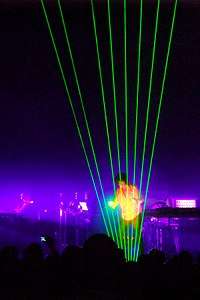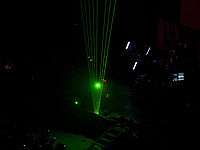Laser harp

A laser harp is an electronic musical user interface and laser lighting display. It projects several laser beams—and a musician plays these by blocking them to produce sounds-reminiscent of a harp. The laser harp has been popularised by Jean Michel Jarre, and has been a high profile feature of almost all his concerts since 1981. British electronic musician Little Boots has used a similar instrument in concerts. The British electro jazz band 1201-Alarm feature a laser harp as a main aspect of their live show.
Laser harps have appeared in a number of designs. They have also been used in public art installations, such as those by Jen Lewin at the Lincoln Center in 2000 and at Burning Man in 2005 and 2012,[1][2] as well as those created by Johnny Dwork at the Harmony Festival in 2011, at the Portland Art Museum in 2012, at The Tech Museum of Innovation in 2014, and at the Oregon Museum of Science and Industry in 2015.[3]
Design
Unframed style, also known as "Infinite Beam" laser harps

This style of laser harp is generally built using a single laser, splitting its beam into an array of beams in parallel or fan arrangement. Playing the actual sound is usually handled by connecting the laser harp to a synthesiser, sampler or computer.
This frameless design is more elaborate than the framed style, relying on reflecting the light back to a single photodiode. The fan of laser beams is actually a single beam scanned into a fan pattern. By matching the timing of the reflected beam, the instrument can determine which beam the player is blocking and sound the corresponding note. Alternative designs use multiple lasers. In these designs, each laser can be independently controlled (pulsed on and off) to simulate playback of prerecorded notes.
Several techniques generate more control data, such as a continuous range of values like those in typical MIDI controllers:
- An infrared or ultrasonic rangefinder attached to the instrument that determines the position of the hand that blocks a beam
- A laser-based rangefinder that determines the distance from the hand to the laser's starting or ending point (and possibly using this laser itself as the string)—or a variation of this that uses the intensity of the sensor signal itself
- A camera that tracks position and motion of the laser dot on the hand, or length of the exposed beam if visible, then calculates a continuous value based upon a reference
The first of these is relatively inexpensive and straightforward to implement, and can use the same micro-controller that drives the lasers and reads the detectors.
The advantage of a dedicated sensor mechanism is that the instrument can be self-contained, as opposed to requiring a computer to control it with input from an ILDA interface and USB camera. The PC-based approach, however, offers more flexibility and can be constructed with mostly off-the-shelf hardware.
Unframed laser harps benefit from the use of higher-power lasers, as they facilitate easier detection by the sensor system. As the sensor is exposed to all ambient light, it can be swamped by stage lighting behind the artist if the sensitivity is too high. To avoid this, the system can use ambient light sensors to reject ambient light. The player may use white or light-coloured gloves to improve performance by scattering more light off the player's hands to provide the sensor with a higher signal-to-noise ratio with respect to ambient light. Furthermore, the gloves protect the player's skin from potentially hazardous laser radiation and give audiences a more visual impression of the instrument.
Bi-colour laser harps
In 2008 Maurizio Carelli, an Italian software and electronic engineer, had the idea of a bicolour (red/green) laser harp. This device features a configurable full octave with green beams for any diatonic note and red ones for any chromatic note for full Diatonic and Chromatic scale.[4] In this way any musician can easily play a laser harp, fully polyphonic. This machine became the first portable bicolor laser harp, and it is still in production. In the second half of 2010, Carelli also designed an ILDA full color laser harp controller.
Unframed style, "Image recognition" laser harp
The image recognition laser harp is also an unframed design, but uses a high-speed USB camera connected to a laptop computer, instead of a photodiode to detect the reflected light from the hand breaking the beam. The digital picture is analyzed by the computer software to determine which beam is broken and send the appropriate MIDI signal back to the synthesiser, which is responsible for creating the sound. The computer also controls the laser projector via an ILDA USB laser controller.
Framed style
The framed style, which is often created to look like a harp with strings, uses an array of photodiodes or photoresistors inside the upper or lower part of the frame to detect blocking of the laser beams. The framed harp built by Geoffrey Rose in 1975/6 was an octagonal shape with a 5 X 5 matrix of laser beams. The lasers can be mounted on the 'neck' or upper side of the harp, shining down, or on the body, shining up. Typically, the lasers used are very low-powered 5 mW red or green lasers, which are considered safe for public interaction by the FDA. Any number of laser beams can be arranged in this type of laser harp, from as few as one or two, up to 32 or more, depending on the capacity of the MIDI controller(s) and software being used. This style of Laser Harp can be created in any size, from a lap sized harp to a room sized installation, or larger, like the installations seen at Burning Man. In this design, only an analog DC (on/off) trigger is created by the breaking of the beam (and the DC circuit made by the beam shining on the optic sensor), which is sufficient to trigger any number of events (musical or otherwise) as determined by the data analyzer/software in question. In the MIDI controller, this analog DC current interruption is converted to a digital signal, which is then used to trigger many possible events or actions. Some software comes equipped with full wave file editors and synthesizers, and can also trigger video and still imagery via projection units.
Safety considerations
Producing laser beams that are visible in normal air requires a relatively powerful laser, at least 20 mW, depending on the laser type and instrument design. However, it takes a considerably more powerful laser to yield visually spectacular results, generally 500 mW or more. In any case, class IIIb or IV lasers are usually necessary, introducing a significant risk of skin and eye damage unless the player wears gloves and protective glasses.
Use in Jean-Michel Jarre concerts
Jean Michel Jarre uses the laser harp in almost every concert, with the exception of Aero and the Oxygene 30th Anniversary Tour. He almost always uses it in the third part of Second Rendez-Vous, but has also used it for tracks like Third Rendez-Vous, Chronologie 3, Calypso 2, Oxygene 7 and Time Machine. The characteristic sound of the laser harp in Jarre's performances comes from a factory preset on the Elka Synthex[5][6] synthesiser.
The first laser harp that Jarre used for The Concerts In China tour, was made by Denis Carnus, a French engineer living in the south of France who has frequently worked with Bernard Szajner. On the recording, the track was simply titled Laser Harp (or Harpe Laser in its original French).
A different laser-harp was used by JM Jarre in the Houston, Lyon, and London concerts: this one was built by Philippe Guerre.
The laser harp for the La Defense concert was built by Claude Lifante.
After that, JM Jarre used a laser-harp built by Up-Tech French company. This harp has been used by JM Jarre for fifteen years, supported by two technicians: Denis Benoit and Laurent de La Casinière.
Some people suspect the laser harp, as well as some other custom instruments, is a fake; careful inspection of concert footage of Jarre playing the harp occasionally indicates that striking the same beam produces different notes, suggesting that the harp is simply designed to trigger the next correct note irrespective of which beam is broken. However, this method is unreliable, as videos are invariably edited before release. As an example, in the live recording of the Paris La Défense concert as broadcast on the Europe 2 radio station, it can be clearly heard that the laser harp is malfunctioning, and in fact after a while gets replaced by a different synthesiser. In the video release, no trace is left of this malfunction. Also the harp is fitted with foot pedals for selecting scales, making it quite plausible that the same beam can trigger different notes.
During Jarre's 2009 In-doors Arena Tour, he commented on his blog that he "should make a few intentional mistakes for people to really understand that it is live".[7] Later the same day, at a concert in Helsinki, the harp "suddenly froze in Rendez Vous 2 for unknown reasons".[8][9]
Inventors
Two people claim to be the inventor of the laser harp: Geoffrey Rose and Bernard Szajner. Geoffrey Rose took out a provisional patent with the British Patent office in 1975/6. Bernard Szajner has a Patent (it means that the Office Patent of Paris never found evidence of another inventor of the same/similar instrument before him). (Patent: FR2502823 (A1) Date de priorité : 1981-03-27).[10] Several amateur electronics enthusiasts have also created their own versions of the laser harp.
See also
References
- ↑ "Burning Man 2012 Honorarium Art Projects".
- ↑ "Jen Lewin Studio Art Exhibits".
- ↑ "L'Ha Laser Harp Alembic".
- ↑ Maurizio Carelli (2010-01-18). ""Kromalaser Hymn" played with Bi-Colour Laser Harp". Retrieved 2010-03-07.
- ↑ JMPSynth (2009-04-01). "Elka Synthex Sounds". Retrieved 2009-04-01.
- ↑ Wavebox2011 (2011-02-27). "Elka Synthex Laser Harp". Retrieved 2011-02-27.
- ↑ Jean Michel Jarre (2009-05-16). "Scandinavian ellipsis". Retrieved 2009-05-25.
- ↑ Jean Michel Jarre (2009-05-17). "Flash back". Retrieved 2009-05-25.
- ↑ Jean Michel Jarre (2009-05-26). "Freezing laserharp @1:08".
- ↑ "Laser Harp Patented by Bernard Szajner". Laser Harp Patent - Patent Office of Paris. Retrieved 14 September 2011.
